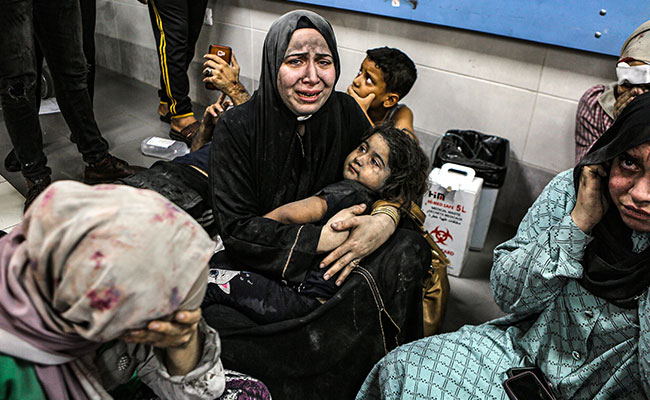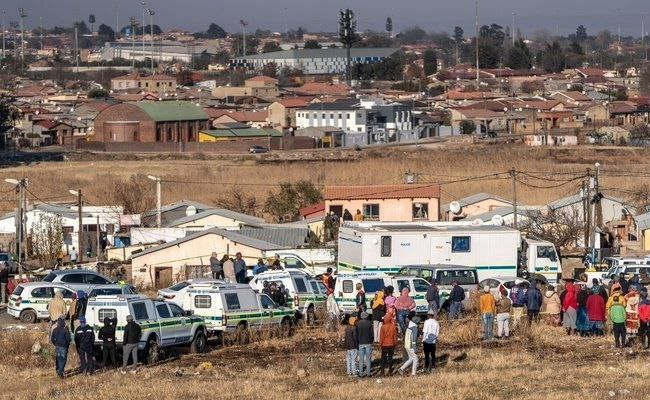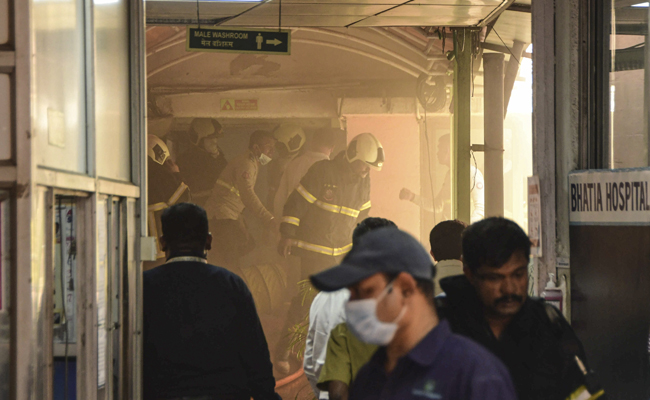The analysis was originally published by New York Times on their website, this report is an aggregation of the original report published by New York Times. You can read the original report by clicking here. The original report was authored by Aric Toler, Haley Willis, Riley Mellen, Alexander Cardia, Natalie Reneau, Julian E. Barnes and Christoph Koettl
In a video captured, a projectile can be seen piercing the night skies over Gaza, followed by an explosion in mid-air. Moments later, another blast rocks the ground below. This footage has gained significant attention, serving as a crucial piece of evidence. Israeli and American officials have referenced this video to support their claim that a Palestinian rocket went off course, malfunctioned in flight, and tragically led to a fatal explosion at Al-Ahli Arab Hospital in Gaza City.
An analysis conducted by The New York Times challenges the initial interpretation of the video footage. Contrary to the previous assumption, the detailed examination of the clip, sourced from an Al Jazeera television camera livestreaming on the night of October 17, reveals a different narrative. The missile captured in the video is highly unlikely to be the source of the hospital explosion. The Times determined that it detonated in the sky approximately two miles away. Importantly, this incident appears to be unrelated to the tragic events at Al-Ahli Arab Hospital, representing a separate aspect of the conflict unfolding along the Israeli-Gaza border that night.
The New York Times' investigation, while shedding light on the missile's detonation at a considerable distance from Al-Ahli Arab Hospital, leaves critical questions unanswered. Specifically, the analysis does not definitively identify the cause of the hospital blast or assign responsibility.
What becomes evident from The Times' analysis is the complexity of the situation. It introduces doubt into the previously clear-cut narrative that Israeli officials presented. The widely publicized evidence they relied on has been called into question, casting questions on the overall understanding of the incident.
Against the backdrop of escalating conflict, the Al-Ahli Arab Hospital blast has emerged as a highly contentious event. The conflict began on October 7 when Hamas, launched an attack on Israel. The Israeli government claims that this attack resulted in the deaths of over 1,400 civilians and soldiers, with 200 hostages taken back to Gaza. In response, Israel initiated a relentless artillery and bombing campaign, causing significant casualties. According to the Hamas-run Gazan Health Ministry, this campaign has led to the death of 5,700 Palestinians. The situation remains volatile, with the Israeli military gearing up for a potential ground invasion.
The responsibility for the Al-Ahli Arab explosion is a matter of intense dispute, with Israeli officials and Palestinians each pointing fingers at the other. The New York Times analysis, studying multiple videos that provided crucial insights revealed that Hamas had been launching numerous rockets from the southwest of the hospital just moments before the blast occurred. The fiery explosion at the hospital aligns with the characteristics of a failed rocket, indicating that it fell significantly short of its intended target and still contained unspent fuel. These findings suggest a scenario where a misfired rocket could have led to the tragic incident at Al-Ahli Arab Hospital.
Further examination of the footage indicates ongoing Israeli bombardment in the vicinity. Within two minutes of the hospital being struck, the videos capture two additional explosions near the same location. Major Nir Dinar, an Israeli military spokesman, informed The New York Times that military forces were not targeting "within a range that endangered the hospital." However, he refrained from specifying the distance of the nearest strike, leaving key details unanswered.
The reported death toll from the incident, initially stated as 500 by Hamas and later revised to 471, remains uncertain. Western intelligence agencies believe the actual number to be considerably lower, but as of now, no verified figure has been established. It is noteworthy that the hospital itself was not directly struck; instead, whatever caused the explosion hit the hospital courtyard, where people had gathered for safety, along with a few parked cars.
The report further added that the investigation into the incident at Al-Ahli Arab Hospital has faced challenges in determining the source of the explosion. The size of the crater left by the impact, which was relatively small, has been highlighted by Israel as evidence that their munitions were not responsible. This fact could be consistent with various types of munitions. “Hamas, on the other hand, has not presented any remnants of Israeli munitions or other physical evidence to support their claim that Israel is accountable for the explosion,” it added.
U.S. intelligence officials stated on Tuesday that their agencies had evaluated the video footage, concluding that it depicts a Palestinian rocket launched from Gaza experiencing a "catastrophic motor failure." According to this assessment, a portion of the rocket subsequently crashed into the hospital grounds, leading to the explosion. A senior intelligence official emphasized that while they could not rule out the possibility of new information emerging that might alter their assessment, they currently held high confidence in their conclusions.
In response to NYT’s findings, a spokesman for the Office of the Director of National Intelligence noted the differing interpretations of the video between NYT and American intelligence agencies. Understanding the events is notably complicated due to the ongoing exchange of fire between Israel and Hamas since the onset of the conflict.
The conflict has seen a relentless offensive from Israel, with over 8,000 munitions fired into Gaza. This extensive barrage constitutes a brutal assault on the region. Furthermore, video evidence and the hospital's official Facebook page confirm that Al-Ahli Arab Hospital had been struck earlier by an illumination artillery shell from Israel.
Hamas has continued launching deadly rockets at Israel from concealed sites within Gaza. It's known that Palestinian rockets have malfunctioned in the past; approximately 15 percent of rockets launched by Gazan militant groups are estimated to fail, the NYT report added. Following the hospital blast, an information war ensued. Hamas attributed the incident to an Israeli airstrike, while the Israel Defense Forces quickly denied responsibility and instead attributed the explosion to a malfunctioning Palestinian rocket.
Israeli officials released a report on October 18 regarding the explosion at Al-Ahli Arab Hospital. They also disclosed one intercepted conversation among Hamas fighters, implicating Islamic Jihad for the blast. Israel has referenced additional undisclosed evidence, including military activity logs, radar system data, other intercepted audio, and further videos to support their claims.
Israeli officials have consistently referenced the Al-Jazeera video in media interviews and social media. The Israel Defense Forces shared the Al Jazeera video footage three times on X (formerly known as Twitter). In these posts, the Israeli military identified the moving aerial object as a "rocket aimed at Israel" that "misfired and exploded" almost simultaneously with the Al-Ahli Arab Hospital blast. Spokesmen for the Israeli military explicitly identified this munition as the misfired rocket responsible for the explosion in interviews with major news outlets, including CNN and the BBC on October 18, as well as in an interview with India Today on October 19.
Despite being widely circulated and cited by numerous media outlets as evidence of a Palestinian rocket hitting the hospital, The New York Times has reached a different conclusion about the video. According to their analysis, the missile in the video was never in close proximity to the hospital. Instead, it was launched from Israel, not Gaza, and seemed to have exploded above the Israeli-Gaza border, at least two miles away from the hospital.
The New York Times analysis traced the object in the sky back to its origin in Israeli territory. To achieve this, it synchronized the Al Jazeera footage with five other videos filmed simultaneously, including footage from Channel 12, an Israeli television station, and a CCTV camera in Tel Aviv. These diverse videos offered perspectives from the north, south, east, and west. By triangulating the launch point using satellite imagery from these sources, NYT determined that the projectile was fired towards Gaza from the vicinity of the Israeli town of Nahal Oz, shortly before the tragic incident at the hospital. Notably, these findings align with conclusions reached by some independent online researchers, further supporting the analysis conducted by NYT.
Furthermore, the synchronized analysis of multiple videos revealed a crucial detail: the projectile captured in the Al Jazeera footage was launched after the barrage of Palestinian rockets that Israeli officials had assessed as responsible for the hospital explosion.
The timeline captured in the videos reveals significant events on the evening of October 17. From 6:59 p.m., barrages of Palestinian rockets were fired from two positions, situated southwest and northwest of the Al-Ahli Arab Hospital. These rockets were visibly propelled by their engines, creating flames in the nighttime sky as they moved northeast toward Israel. Importantly, the videos show that there was a gap of more than 25 seconds between the launch of the final Palestinian rocket and the occurrence of the hospital explosion.
The New York Times, despite its extensive analysis, could not independently identify the specific type of projectile that was fired from Israel, although it was launched from an area known to be equipped with an Iron Dome defense system. Notably, the Israeli military has stated that it does not fire Iron Dome interceptors into Gaza, and it is possible that the missile seen in the video did not cross over into Gazan territory. Moreover, the Israeli military has explicitly stated that the Iron Dome system did not shoot any interceptors in the questioned time and area.
For New York Times: Hiba Yazbek contributed reporting from Jerusalem. John Ismay contributed reporting from Washington, D.C. Yousur Al-Hlou contributed reporting from Cairo.
Let the Truth be known. If you read VB and like VB, please be a VB Supporter and Help us deliver the Truth to one and all.
Johannesburg (AP): A 32-year-old suspect has been arrested in connection with a mass shooting which claimed the lives of 12 people including three children at an unlicensed pub earlier this month, South African police said on Monday.
The man is suspected of being one of the three people who opened fire on patrons in a pub at Saulsville township, west of South Africa's capital Pretoria, killing 12 people including three children aged 3, 12 and 16.
At least 13 people were also injured during the attack, whose motive remains unknown.
According to the police, the suspect was arrested on Sunday while traveling to Botlokwa in Limpopo province, more than 340 km from where the mass shooting took place on Dec 6.
An unlicensed firearm believed to have been used during the attack was recovered from the suspect's vehicle.
“The 32-year-old suspect was intercepted by Limpopo Tracking Team on the R101 Road in Westenburg precinct. During the arrest, the team recovered an unlicensed firearm, a hand gun, believed to have been used in the commission of the multiple murders. The firearm will be taken to the Forensic Science Laboratory for ballistic analysis,” police said in statement.
The suspect was arrested on the same day that another mass shooting at a pub took place in the Bekkersdal township, west of Johannesburg, in which nine people were killed and 10 wounded when unknown gunmen opened fire on patrons.
Police have since launched a search for the suspects.
South Africa has one of the highest homicide rates in the world and recorded more than 26,000 homicides in 2024 — an average of more than 70 a day. Firearms are by far the leading cause of death in homicides.
The country of 62 million people has relatively strict gun ownership laws, but many killings are committed with illegal guns, according to authorities.
According to police, mass shootings at unlicensed bars are becoming a serious problem. Police shut down more than 11,000 illegal taverns between April and September this year and arrested more than 18,000 people for involvement in illegal liquor sales.





